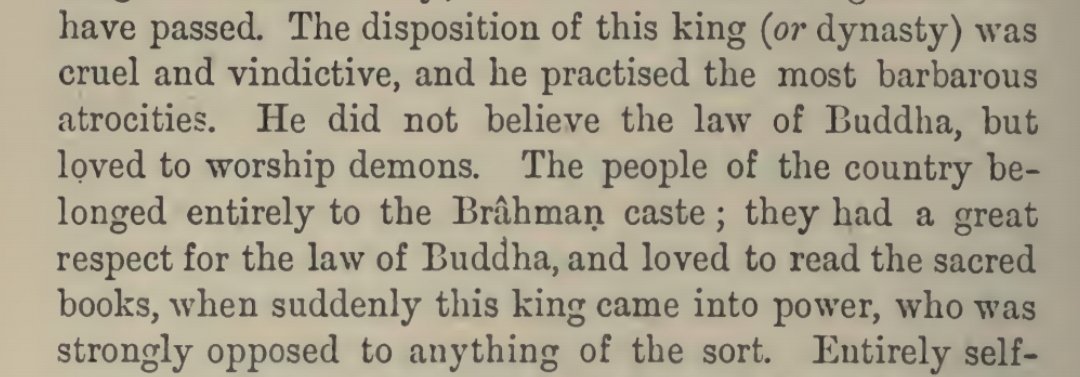
1.
#Thread on the great ruler of Māḷwā - Yashodharman of Aulikār dynasty.
He is most well-known for defeating the Hun ruler Mihirakula.
#Thread on the great ruler of Māḷwā - Yashodharman of Aulikār dynasty.
He is most well-known for defeating the Hun ruler Mihirakula.

2.
Huns' capital was located in Gāndhār (around Peśāwar and east Afghanistan).
515 CE: Mihirakula's reign started, with initial base at Sialkot.

Huns' capital was located in Gāndhār (around Peśāwar and east Afghanistan).
515 CE: Mihirakula's reign started, with initial base at Sialkot.


3.
To grasp the significance of Yaśodharman's success against Huns, we first look at the cruelty of Mihirakula.
519-20 CE: Chinese traveller Sung Yun records the Hunnic character thus 👇
To grasp the significance of Yaśodharman's success against Huns, we first look at the cruelty of Mihirakula.
519-20 CE: Chinese traveller Sung Yun records the Hunnic character thus 👇

4.
Kalahana's Rājataraṅgini narrates some cruelties as well.
Mihirakula was said to have no "pity for children, clemency for women & respect for the aged"



Kalahana's Rājataraṅgini narrates some cruelties as well.
Mihirakula was said to have no "pity for children, clemency for women & respect for the aged"




5.
530 CE: Through several victories over the Gupta feudatories and the emperor Narsiṃhagupta Bālāditya himself, Mihirakula extended his territory upto (and perhaps beyond) Gwalior.
This is confirmed by a 530 CE's inscription, stating his construction of Sun Temple in Gwalior.
530 CE: Through several victories over the Gupta feudatories and the emperor Narsiṃhagupta Bālāditya himself, Mihirakula extended his territory upto (and perhaps beyond) Gwalior.
This is confirmed by a 530 CE's inscription, stating his construction of Sun Temple in Gwalior.

6.
After 530 CE though, Yaśodharman rises to the moment. He came from the family of Aulikār, the ex-feudatories of Gupta emperor.
After 530 CE though, Yaśodharman rises to the moment. He came from the family of Aulikār, the ex-feudatories of Gupta emperor.

7.
532-3 CE: Mihirakula is soundly defeated by Yaśodharman, and Mihirakula is made a *vassal* of Aulikāras.
The Mandsaur inscription praises Yaśodharman highly for this feat, of humbling one of the cruel & dominant rulers of that time. 👇

532-3 CE: Mihirakula is soundly defeated by Yaśodharman, and Mihirakula is made a *vassal* of Aulikāras.
The Mandsaur inscription praises Yaśodharman highly for this feat, of humbling one of the cruel & dominant rulers of that time. 👇


8.
~534 CE: Narsiṃhgupta Bālāditya, the Gupta emperor, too defeated Mihirakula and drove him back to regions around Sialkot and Kashmir.
Narsiṃhgupta had become emperor ca.510 CE but forced to pay tribute to Mihirakula around 530.
A/c to Hieun Tsang, Mihirakula died ~535 CE.

~534 CE: Narsiṃhgupta Bālāditya, the Gupta emperor, too defeated Mihirakula and drove him back to regions around Sialkot and Kashmir.
Narsiṃhgupta had become emperor ca.510 CE but forced to pay tribute to Mihirakula around 530.
A/c to Hieun Tsang, Mihirakula died ~535 CE.


9.
In the same 533 CE Mandsaur inscription (of tweet #7 ☝️), the territory of Yaśodharman is indicated.
It is said to have boundaries defined by Mahendra mountain (on Odisha-AP border), Himalayas, Brahmaputra and Western Ocean (today's Arabian sea)

In the same 533 CE Mandsaur inscription (of tweet #7 ☝️), the territory of Yaśodharman is indicated.
It is said to have boundaries defined by Mahendra mountain (on Odisha-AP border), Himalayas, Brahmaputra and Western Ocean (today's Arabian sea)


10.
However this huge territory wasn't to stay in empire for long.
Yaśodharman is said to have passed away / significantly weakened by 540s.
Inscriptions and grants confirm Gupta suzerainty:-
543: N.Bengal
550: Gujarat
569: Kaliṅga
570: Death of Last Gupta ruler, Vishnugupta.
However this huge territory wasn't to stay in empire for long.
Yaśodharman is said to have passed away / significantly weakened by 540s.
Inscriptions and grants confirm Gupta suzerainty:-
543: N.Bengal
550: Gujarat
569: Kaliṅga
570: Death of Last Gupta ruler, Vishnugupta.

11.
These inscriptions & grants prove the oft-repeated metaphor for Yaśodharman's rule - *rose and fell like a meteor*
These inscriptions & grants prove the oft-repeated metaphor for Yaśodharman's rule - *rose and fell like a meteor*

12.
Nevertheless, the 'meteor' of Yaśodharman fulfilled the wish of Bhāratiyas to finally become free from the Hunnic menace.
His story will continue to inspire us while facing cruel invaders!
#Hindutva #History #HinduHero

Nevertheless, the 'meteor' of Yaśodharman fulfilled the wish of Bhāratiyas to finally become free from the Hunnic menace.
His story will continue to inspire us while facing cruel invaders!
#Hindutva #History #HinduHero


• • •
Missing some Tweet in this thread? You can try to
force a refresh























